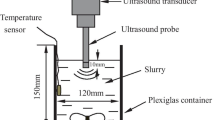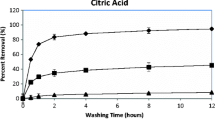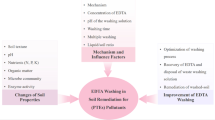Abstract
Purpose
Ethylenediaminetetraacetic acid (EDTA)-enhanced soil washing is an important technique of removing potentially toxic elements (PTEs) from contaminated soils. Conventional mechanical shaking (CMS) method is widely adopted in soil washing. However, it consumes a considerable amount of time and energy. Extraction methods which need less contact time or power, such as static equilibrium extraction (SEE) and ultrasound-assisted extraction (UAE), are potential to replace CMS in industrial application.
Methods
The washing process of the soil from a contaminated site was optimized by investigating various extraction conditions, including EDTA concentration, contact time, and different extraction methods, such as CMS, SEE, and UAE, in this study.
Results
The results indicated that EDTA greatly enhanced the removal of cadmium (Cd), copper (Cu), lead (Pb), and zinc (Zn) from the soil. The EDTA was more effective in removing Pb and Cu than Cd and Zn, regardless of the extraction method. This might be mainly attributed to the strong complexation capacity of EDTA with Pb and Cu and geochemical distribution of the target PTEs. The three extraction methods were almost equally efficient, while SEE required less energy and UAE needed shortened contact time compared with CMS.
Conclusion
Based on the above results, SEE and UAE are promising alternatives to CMS for cleaning up PTEs-contaminated soils.





Similar content being viewed by others
References
Andrade M, Prasher S, Hendershot W (2007) Optimizing the molarity of a EDTA washing solution for saturated-soil remediation of trace metal contaminated soils. Environ Pollut 147:781–790
Bandara T, Franks A, Xu J, Bolan N, Wang H, Tang C (2020) Chemical and biological immobilization mechanisms of potentially toxic elements in biochar-amended soils. Crit Rev Environ Sci Technol 50:903–978
Begum ZA, Rahman IM, Tate Y, Sawai H, Maki T, Hasegawa H (2012) Remediation of toxic metal contaminated soil by washing with biodegradable aminopolycarboxylate chelants. Chemosphere 87:1161–1170
Beiyuan J, Li J, Tsang DCW, Wang L, Poon CS, Li XD, Fendorf S (2017a) Fate of arsenic before and after chemical-enhanced washing of an arsenic-containing soil in Hong Kong. Sci Total Environ 599-600:679–688
Beiyuan J, Tsang DCW, Valix M, Zhang W, Yang X, Ok YS, Li XD (2017b) Selective dissolution followed by EDDS washing of an e-waste contaminated soil: extraction efficiency, fate of residual metals, and impact on soil environment. Chemosphere 166:489–496
Beiyuan J, Lau AYT, Tsang DCW, Zhang W, Kao C-M, Baek K, Ok YS, Li X-D (2018a) Chelant-enhanced washing of CCA-contaminated soil: coupled with selective dissolution or soil stabilization. Sci Total Environ 612C:1463–1472
Beiyuan J, Tsang DCW, Valix M, Baek K, Ok YS, Zhang W, Bolan NS, Rinklebe J, Li X-D (2018b) Combined application of EDDS and EDTA for removal of potentially toxic elements under multiple soil washing schemes. Chemosphere 205:178–187
Beiyuan J, Awad YM, Beckers F, Wang J, Tsang DCW, Ok YS, Wang S-L, Wang H, Rinklebe J (2020) (Im)mobilization and speciation of lead under dynamic redox conditions in a contaminated soil amended with pine sawdust biochar. Environ Int 135:105376
Bolan N, Kunhikrishnan A, Thangarajan R, Kumpiene J, Park J, Makino T, Kirkham MB, Scheckel K (2014) Remediation of heavy metal(loid)s contaminated soils--to mobilize or to immobilize? J Hazard Mater 266:141–166
Chen F, Tan M, Ma J, Li G, Qu J (2016) Restoration of manufactured gas plant site soil through combined ultrasound-assisted soil washing and bioaugmentation. Chemosphere 146:289–299
Chen H, Yang X, Wang H, Sarkar B, Shaheen SM, Gielen G, Bolan N, Guo J, Che L, Sun H, Rinklebe J (2020) Animal carcass- and wood-derived biochars improved nutrient bioavailability, enzyme activity, and plant growth in metal-phthalic acid ester co-contaminated soils: a trial for reclamation and improvement of degraded soils. J Environ Manage 261:110246
De La Calle I, Cabaleiro N, Lavilla I, Bendicho C (2013) Ultrasound-assisted single extraction tests for rapid assessment of metal extractability from soils by total reflection X-ray fluorescence. J Hazard Mater 260:202–209
de La Rochebrochard S, Naffrechoux E, Drogui P, Mercier G, Blais J-F (2013) Low frequency ultrasound-assisted leaching of sewage sludge for toxic metal removal, dewatering and fertilizing properties preservation. Ultrason Sonochem 20:109–117
Dermont G, Bergeron M, Mercier G, Richer-Lafleche M (2008) Soil washing for metal removal: a review of physical/chemical technologies and field applications. J Hazard Mater 152:1–31
Gheju M, Pode R, Manea F (2011) Comparative heavy metal chemical extraction from anaerobically digested biosolids. Hydrometallurgy 108:115–121
Gogate PR, Sutkar VS, Pandit AB (2011) Sonochemical reactors: important design and scale up considerations with a special emphasis on heterogeneous systems. Chem Eng J 166:1066–1082
Gusiatin ZM, Klimiuk E (2012) Metal (Cu, Cd and Zn) removal and stabilization during multiple soil washing by saponin. Chemosphere 86:383–391
Han R, Dai H, Zhan J, Wei S (2019) Clean extracts from accumulator efficiently improved Solanum nigrum L. accumulating Cd and Pb in soil. J Clean Prod 239:118055
Hasegawa H, Mamun MAA, Tsukagoshi Y, Ishii K, Sawai H, Begum ZA, Asami MS, Maki T, Rahman IMM (2019) Chelator-assisted washing for the extraction of lead, copper, and zinc from contaminated soils: a remediation approach. Appl Geochem 109:104397
Hashemi M, Jahanshahi N, Habibi A (2012) Application of ultrasound-assisted emulsification microextraction for determination of benzene, toluene, ethylbenzene and o-xylene in water samples by gas chromatography. Desalination 288:93–97
Hwang S-S, Park J-S, Namkoong W (2007) Ultrasonic-assisted extraction to release heavy metals from contaminated soil. J Ind Eng Chem 13:650–656
Klik B, Kulikowska D, Gusiatin ZM, Pasieczna-Patkowska S (2020) Washing agents from sewage sludge: efficiency of Cd removal from highly contaminated soils and effect on soil organic balance. J Soil Sediment 20:284–296
Kovács K, Halász G, Takács A, Heltai G, Széles É, Győri Z, Horváth M (2018) Study of ultrasound-assisted sequential extraction procedure for potentially toxic element content of soils and sediments. Microchem J 136:80–84
Labanowski J, Monna F, Bermond A, Cambier P, Fernandez C, Lamy I, van Oort F (2008) Kinetic extractions to assess mobilization of Zn, Pb, Cu, and Cd in a metal-contaminated soil: EDTA vs. citrate. Environ Pollut 152:693–701
Lestan D, Luo CL, Li XD (2008) The use of chelating agents in the remediation of metal-contaminated soils: a review. Environ Pollut 153:3–13
Li Y, Hu X, Song X, Sun T (2012) Remediation of cadmium-contaminated soil by extraction with para-sulphonato-thiacalix[4]arene, a novel supramolecular receptor. Environ Pollut 167:93–100
Li J, Wang S-L, Zhang J, Zheng L, Chen D, Wu Z, Shaheen SM, Rinklebe J, Ok YS, Wang H, Wu W (2020) Coconut-fiber biochar reduced the bioavailability of lead but increased its translocation rate in rice plants: elucidation of immobilization mechanisms and significance of iron plaque barrier on roots using spectroscopic techniques. J Hazard Mater 389:122117
Lim M, Ashokkumar M, Son Y (2014) The effects of liquid height/volume, initial concentration of reactant and acoustic power on sonochemical oxidation. Ultrason Sonochem 21:1988–1993
Liu L, Li W, Song W, Guo M (2018) Remediation techniques for heavy metal-contaminated soils: principles and applicability. Sci Total Environ 633:206–219
Liu J, Luo X, Sun Y, Tsang DCW, Qi J, Zhang W, Li N, Yin M, Wang J, Lippold H, Chen Y, Sheng G (2019a) Thallium pollution in China and removal technologies for waters: a review. Environ Int 126:771–790
Liu J, Ren S, Zhou Y, Tsang DCW, Lippold H, Wang J, Yin M, Xiao T, Luo X, Chen Y (2019b) High contamination risks of thallium and associated metal(loid)s in fluvial sediments from a steel-making area and implications for environmental management. J Environ Manage 250:109513
Lu R (1999) Analytical methods of soil agrochemistry. China Agricultural Science and Technology Press, Beijing, pp 85–96
Mao G, Shi T, Zhang S, Crittenden J, Guo S, Du H (2018) Bibliometric analysis of insights into soil remediation. J Soil Sediment 18:2520–2534
Matong JM, Nyaba L, Nomngongo PN (2016) Fractionation of trace elements in agricultural soils using ultrasound assisted sequential extraction prior to inductively coupled plasma mass spectrometric determination. Chemosphere 154:249–257
Meng W, Chen J, Wang X (2016) Removal of arsenic and cadmium with sequential soil washing techniques using Na 2 EDTA, oxalic and phosphoric acid: optimization conditions, removal effectiveness and ecological risks. Chemosphere 156:252–261
Meng F, Yuan G, Wei J, Bi D, Ok YS, Wang H (2017) Humic substances as a washing agent for Cd-contaminated soils. Chemosphere 181:461–467
Nowack B, Sigg L (1997) Dissolution of Fe(III) (hydr) oxides by metal-EDTA complexes. Geochim Cosmochim Ac 61:951–963
Nowack B, Schulin R, Robinson BH (2006) Critical assessment of chelant-enhanced metal phytoextraction. Environ Sci Technol 40:5225–5231
Park B, Son Y (2017) Ultrasonic and mechanical soil washing processes for the removal of heavy metals from soils. Ultrason Sonochem 35:640–645
Pham TD, Shrestha RA, Virkutyte J, Sillanpää M (2013) Recent studies in environmental applications of ultrasound. J Environ Eng Sci 8:403–412
Picó Y (2013) Ultrasound-assisted extraction for food and environmental samples. TrAC-Trend Anal Chem 43:84–99
Rinklebe J, Shaheen SM, El-Naggar A, Wang H, Du Laing G, Alessi DS, Sik Ok Y (2020) Redox-induced mobilization of Ag, Sb, Sn, and Tl in the dissolved, colloidal and solid phase of a biochar-treated and un-treated mining soil. Environ Int 140:105754
Santos EVD, Sáez C, Cañizares P, Martínez-Huitle CA, Rodrigo MA (2016) UV assisted electrochemical technologies for the removal of oxyfluorfen from soil washing wastes. Chem Eng J 318:2–9
Son Y, Cha J, Lim M, Ashokkumar M, Khim J (2011) Comparison of ultrasonic and conventional mechanical soil-washing processes for diesel-contaminated sand. Ind Eng Chem Res 50:60–64
Son Y, Nam S, Ashokkumar M, Khim J (2012) Comparison of energy consumptions between ultrasonic, mechanical, and combined soil washing processes. Ultrason Sonochem 19:395–398
Son Y, Lee D, Lee W, Park J, Hyoung Lee W, Ashokkumar M (2019) Cavitational activity in heterogeneous systems containing fine particles. Ultrason Sonochem 58:104599
Tandy S, Bossart K, Mueller R, Ritschel J, Hauser L, Schulin R, Nowack B (2004) Extraction of heavy metals from soils using biodegradable chelating agents. Environ Sci Technol 38:937–944
Tessier A, Campbell PGC, Bisson M (1979) Sequential extraction procedure for the speciation of particulate trace metals. Anal Chem 51:844–851
Tsang DCW, Hartley NR (2014) Metal distribution and spectroscopic analysis after soil washing with chelating agents and humic substances. Environ Sci Pollut Res 21:3987–3995
Tsang DCW, Zhang WH, Lo IMC (2007) Copper extraction effectiveness and soil dissolution issues of EDTA-flushing of artificially contaminated soils. Chemosphere 68:234–243
Walkley A (1935) An examination of methods for determining organic carbon and nitrogen in soils. J Agr Sci 25:598–609
Wang J, Jiang J, Li D, Li T, Li K, Tian S (2015) Removal of Pb and Zn from contaminated soil by different washing methods: the influence of reagents and ultrasound. Environ Sci Pollut Res 22:20084–20091
Wang L, Ok YS, Tsang DCW, Alessi DS, Rinklebe J, Wang H, Mašek O, Hou R, O’Connor D, Hou D (2020) New trends in biochar pyrolysis and modification strategies: feedstock, pyrolysis conditions, sustainability concerns and implications for soil amendment. Soil Use Manage. https://doi.org/10.1111/sum.12592
Wu P, Cui P, Alves ME, Peijnenburg WJGM, Liu C, Zhou D, Wang H, Ok YS, Wang Y (2019) Interactive effects of rice straw biochar and γ-Al2O3 on immobilization of Zn. J Hazard Mater 373:250–257
Xia S, Song Z, Jeyakumar P, Shaheen SM, Rinklebe J, Ok YS, Bolan N, Wang H (2019) A critical review on bioremediation technologies for Cr(VI)-contaminated soils and wastewater. Crit Rev Environ Sci Technol 49:1027–1078
Xu X, Liu X, Li Y, Ran Y, Liu Y, Zhang Q, Li Z, He Y, Xu J, Di H (2017) High temperatures inhibited the growth of soil bacteria and archaea but not that of fungi and altered nitrous oxide production mechanisms from different nitrogen sources in an acidic soil. Soil Biol Biochem 107:168–179
Yoo JC, Beiyuan J, Wang L, Tsang DCW, Baek K, Bolan NS, Ok YS, Li XD (2018) A combination of ferric nitrate/EDDS-enhanced washing and sludge-derived biochar stabilization of metal-contaminated soils. Sci Total Environ 616-617:572–582
Zhai X, Li Z, Huang B, Luo N, Huang M, Zhang Q, Zeng G (2018) Remediation of multiple heavy metal-contaminated soil through the combination of soil washing and in situ immobilization. Sci Total Environ 635:92–99
Zhang W, Huang H, Tan F, Wang H, Qiu R (2010) Influence of EDTA washing on the species and mobility of heavy metals residual in soils. J Hazard Mater 173:369–376
Zhang T, Liu JM, Huang XF, Xia B, Su CY, Luo GF, Xu YW, Wu YX, Mao ZW, Qiu RL (2013) Chelant extraction of heavy metals from contaminated soils using new selective EDTA derivatives. J Hazard Mater 262:464–471
Zhao FJ, Ma Y, Zhu YG, Tang Z, McGrath SP (2015) Soil contamination in China: current status and mitigation strategies. Environ Sci Technol 49:750–759
Zhao T, Zhang K, Chen J, Shi X, Li X, Ma Y, Fang G, Xu S (2019) Changes in heavy metal mobility and availability in contaminated wet-land soil remediated using lignin-based poly(acrylic acid). J Hazard Mater 368:459–467
Zou Z, Qiu R, Zhang W, Dong H, Zhao Z, Zhang T, Wei X, Cai X (2009) The study of operating variables in soil washing with EDTA. Environ Pollut 157:229–236
Zupanc V, Kastelec D, Lestan D, Grcman H (2014) Soil physical characteristics after EDTA washing and amendment with inorganic and organic additives. Environ Pollut 186:56–62
Funding
The authors received financial support from the National Natural Science Foundation of China (No. 21876027), the Natural Science Foundation of Guangdong Province, China (No. 2017A030311019), and the Special Fund for the Science and Technology Innovation Team of Foshan, China (No. 1920001000083).
Author information
Authors and Affiliations
Corresponding author
Additional information
Responsible editor: Dong-Mei Zhou
Publisher’s note
Springer Nature remains neutral with regard to jurisdictional claims in published maps and institutional affiliations.
Tao Sun and Jingzi Beiyuan contribute equally to this work and should be considered co-first authors.
Rights and permissions
About this article
Cite this article
Sun, T., Beiyuan, J., Gielen, G. et al. Optimizing extraction procedures for better removal of potentially toxic elements during EDTA-assisted soil washing. J Soils Sediments 20, 3417–3426 (2020). https://doi.org/10.1007/s11368-020-02678-0
Received:
Accepted:
Published:
Issue Date:
DOI: https://doi.org/10.1007/s11368-020-02678-0




